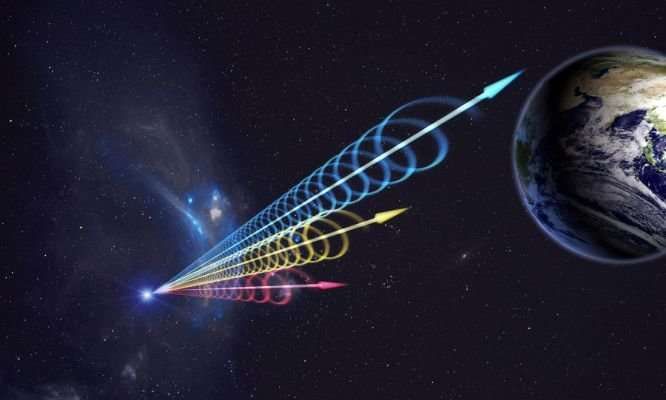Mysterious Radio Signals From Deep Space Detected
by Helen Briggs January 9, 2019 (bbc.com)
• Astronomers at the CHIME (Canadian Hydrogen Intensity Mapping Experiment) observatory in Canada scan the entire northern sky on a daily basis. The observatory, located in British Columbia’s Okanagan Valley, consists of four 100-metre-long, semi-cylindrical antennas. (see image below) The telescope got up and running only last year, detecting 13 ‘fast radio bursts’ (FRBs) almost immediately. One of these was a ”repeater” signal from a distant galaxy 1.5 billion light years away.
• A “repeater” FRB signal has only been reported once before, by another telescope. (see article on the “Wow Signal” here) “We have discovered a second repeater and its properties are very similar to the first repeater,” said Shriharsh Tendulkar of McGill University, Canada.
• Fast radio bursts are short, bright flashes of radio waves which appear to be coming from almost halfway across the Universe. So far, scientists around the world have detected about 60 single fast radio bursts, and two that repeat. They believe there could be as many as a thousand FRBs in the sky every day. Theories about what could be causing them include a neutron star with a very strong magnetic field that is spinning very rapidly, two neutron stars merging together, or even some form of alien spaceship.
• “Knowing that there is another (repeater) suggests that there could be more out there,” said Ingrid Stairs, an astrophysicist from the University of British Columbia (UBC). “And with more repeaters and more sources available for study, we may be able to understand these cosmic puzzles – where they’re from and what causes them.”
• The astronomers’ research was published in the scientific journal Nature.
Astronomers have revealed details of mysterious signals emanating from a distant galaxy, picked up by a telescope in Canada.
The precise nature and origin of the blasts of radio waves is unknown.
Among the 13 fast radio bursts, known as FRBs, was a very unusual repeating signal, coming from the same source about 1.5 billion light years away.
Such an event has only been reported once before, by a different telescope.
“Knowing that there is another suggests that there could be more out there,” said Ingrid Stairs, an astrophysicist from the University of British Columbia (UBC).

“And with more repeaters and more sources available for study, we may be able to understand these cosmic puzzles – where they’re from and what causes them.”
The CHIME observatory, located in British Columbia’s Okanagan Valley, consists of four 100-metre-long, semi-cylindrical antennas, which scan the entire northern sky each day.
FAIR USE NOTICE: This page contains copyrighted material the use of which has not been specifically authorized by the copyright owner. ExoNews.org distributes this material for the purpose of news reporting, educational research, comment and criticism, constituting Fair Use under 17 U.S.C § 107. Please contact the Editor at ExoNews with any copyright issue.
